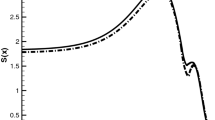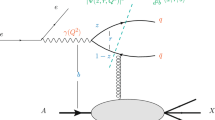Abstract.
We summarize the results of a recent global analysis of proton and deuteron F2 structure function world data performed over a large range of kinematics, including recent measurements done at JLab with the CLAS detector. From these data the lowest moments (n≤10) of the unpolarized structure functions are determined with good statistics and systematics. The Q2 evolution of the extracted moments is analyzed in terms of an OPE-based twist expansion, taking into account soft-gluon effects at large x. A clean separation among the leading- and higher-twist terms is achieved. By combining proton and deuteron measurements the lowest moments of the neutron F2 structure function are determined and its leading-twist term is extracted. Particular attention is paid to nuclear effects in the deuteron, which become increasingly important for the higher moments. Our results for the non-singlet, isovector (p-n) combination of the leading-twist moments are used to test recent lattice simulations. We also determine the lowest few moments of the higher-twist contributions, and find these to be approximately isospin independent, suggesting the possible dominance of ud correlations over uu and dd in the nucleon.
Similar content being viewed by others
References
CLAS Collaboration (M. Osipenko), Phys. Rev. D 67, 092001 (2003) [arXiv:hep-ph/0301204]
CLAS Collaboration (M. Osipenko), Phys. Rev. C 73, 045205 (2006) [arXiv:hep-ex/0506004]
I. Niculescu, J. Arrington, R. Ent, C.E. Keppel, Phys. Rev. C 73, 045206 (2006) [arXiv:hep-ph/0509241].
S. Simula, Phys. Lett. B 493, 325 (2000) [arXiv:hep-ph/0005315].
S. Simula, M. Osipenko, Nucl. Phys. B 675, 289 (2003) [arXiv:hep-ph/0306260].
M. Osipenko, W. Melnitchouk, S. Simula, S. Kulagin, G. Ricco, Nucl. Phys. A 766, 142 (2006) [arXiv:hep-ph/0510189]
LHPC Collaboration (D. Dolgov), Phys. Rev. D 66, 034506 (2002) [arXiv:hep-lat/0201021].
QCDSF Collaboration (M. Gockeler, R. Horsley, D. Pleiter, P.E.L. Rakow, G. Schierholz), Phys. Rev. D 71, 114511 (2005) [arXiv:hep-ph/0410187].
W. Detmold, W. Melnitchouk, J.W. Negele, D.B. Renner, A.W. Thomas, Phys. Rev. Lett. 87, 172001 (2001) [arXiv:hep-lat/0103006].
Author information
Authors and Affiliations
Corresponding author
Rights and permissions
About this article
Cite this article
Simula, S. Leading and higher twists in proton, neutron and deuteron unpolarized structure functions F2 . Eur. Phys. J. A 31, 603–605 (2007). https://doi.org/10.1140/epja/i2006-10246-x
Received:
Accepted:
Published:
Issue Date:
DOI: https://doi.org/10.1140/epja/i2006-10246-x




